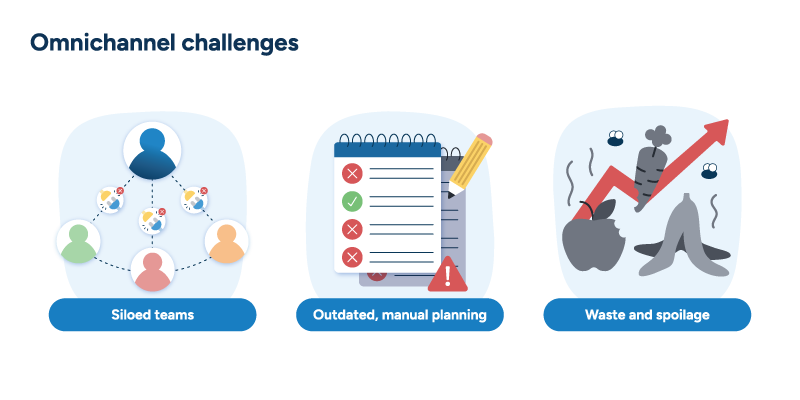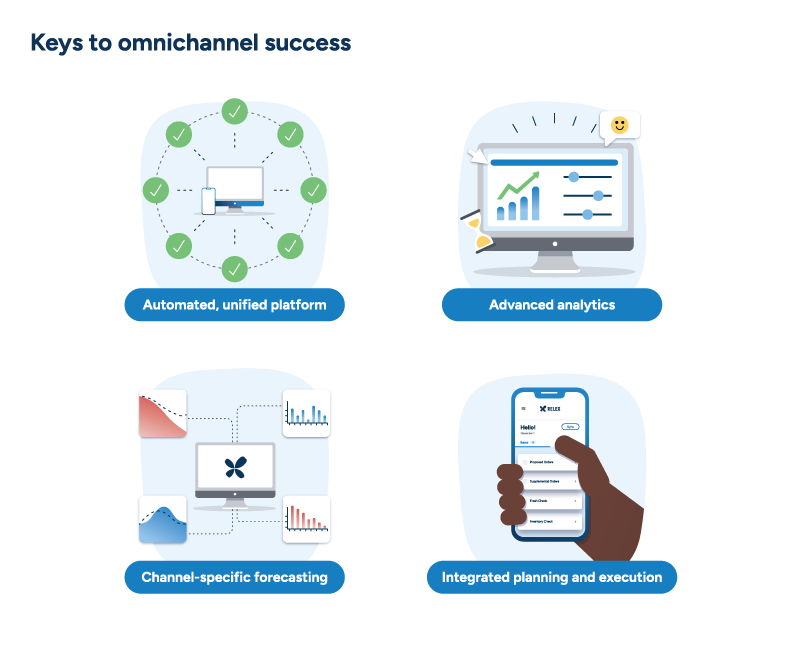From forecast to fulfillment: Grocery planning that protects shoppers from disruption
Aug 1, 2025 • 7 min
Grocery retailers are feeling the pressure to deliver flawless customer experiences, regardless of channel. Unfortunately, they’re also up against supply chain complexity, operational inefficiencies, demand fluctuations, and the impacts of new regulations and tariffs.
Without the right tools to meet these challenges, companies leave customers – and margins – vulnerable to the whims of the market and upstream disruptions. When shoppers regularly can’t find what they need, they’re not thinking about why shelves are empty. They’re just frustrated and more likely to take their business elsewhere.
How can grocery retailers improve their operations to make complexity invisible and deliver consistent, seamless shopping experiences?
With RELEX, businesses can implement a resilient, customer-first planning solution that uses real-time data, AI-powered planning, and connected operations to enhance what customers experience and expect at every touchpoint.
The challenges: When complexity becomes the shopper’s problem
From empty shelves during the lunch rush to pricing discrepancies across channels, inconsistent shopping experiences can destroy a brand’s reputation.

Let’s examine why so many omnichannel processes fail to deliver on promises to customers.
Disconnected systems and execution gaps
The root of many customer frustrations lies in siloed planning.
For instance, when inventory and fulfillment systems can’t share data easily, orders can arrive late or incomplete, hampering in-store execution, reducing on-shelf availability, and frustrating both shoppers and staff.
Uncoordinated promo and pricing strategies present another challenge. Siloed processes lead to inconsistent pricing and availability between channels, resulting in stockouts.
For instance, let’s say the promo team plans a buy-one-get-one (BOGO) promotion for an item, unaware that the pricing team just dropped the price by 10%. The item is listed at different prices in different places, and the misalignment between teams causes a drastic demand spike that inventory levels can’t meet, sowing confusion and disappointment among shoppers.
Learn more: Why retailers need to integrate pricing and promotions
Planning and forecasting limitations
Many retailers still rely on one-size-fits-all forecasting that can’t anticipate true customer demand patterns, making it difficult to ensure availability while maintaining balanced inventory. Without granular forecasts that predict demand behavior for each product-location, it’s easy for retailers to order too much or too little.
Manual planning processes exacerbate these issues. They consume valuable time and effort and make it difficult to respond quickly to changing demand or unexpected disruptions.
Learn more: The complete guide to machine learning in retail demand forecasting
The hidden cost of waste and spoilage
Overordering leads to unmanaged spoilage that damages profit margins as well as customer perceptions of product freshness and quality. No customer wants to pick up a browning banana or a mushy apple, and no retailer wants to lose those sales.
In addition to their weekly shopping list, though, consumers are thinking about the broader implications of waste. Globally, a third of all food is wasted, costing an estimated $940 billion a year. 74% of shoppers reported they would switch to a retailer who commits to reducing food waste and reports on performance to remain accountable.
Without the right planning solutions, grocery retailers miss out on the significant competitive, financial, and environmental opportunities for companies who can demonstrate sustainability improvements.
Implementing a customer-first planning approach
With RELEX, planning and execution teams get the real-time data, cross-functional alignment, and AI and automation capabilities they need to circumvent challenges before they become customer pain points.

An automated, unified planning platform
The RELEX end-to-end grocery platform brings together all the planning functions: forecasting, replenishment, pricing, promotions, and store operations.
It provides integrated visibility and control across the supply chain. It strengthens fulfillment and inventory efficiency through fresh and center-store stock management as well as ring-fencing capabilities for e-commerce and in-store channels.
This advanced, AI-driven planning keeps pricing and product data aligned, no matter where a consumer shops. The solution’s machine learning-based forecasting adjusts to promotional impacts in real time for smoother campaigns, minimal leftover stock, and more consistent pricing.

Plus, the built-in, configurable automation framework frees teams from tedious manual work, allowing them to automate routine tasks and trigger workflows in response to common market occurrences. Planners can get more done, while reducing the frequency and severity of manual errors.
RELEX also enables freshness-first planning, making it easier for companies to track and cut waste, adhere to sustainability goals, and improve margins.
Advanced omnichannel planning
RELEX untangles all the twists and turns of omnichannel operations, synchronizing planning across sales channels while optimizing inventory levels and product availability.
Thanks to advanced analytics and data integration, companies can improve their personalized marketing experiences and streamline order fulfillment.
Furthermore, with channel-specific forecasting, planning teams have a much clearer picture of how demand is dispersed across their omnichannel network. This visibility helps them reduce stockouts and build a reputation of reliability wherever consumers choose to shop.
Near-real time visibility and execution
With RELEX Mobile, companies can easily convey all the information from the planning side of the business to the teams handling inventory on the store floor.
RELEX Mobile gives store associates near real-time visibility into inventory, deliveries, and promotions, putting stock insights and priorities at their fingertips. It also gives them access to updated planograms so that assortments are presented consistently across stores. With real-time stock allocation and visibility, teams can improve fulfillment and ensure customers receive what they expect, when they expect it.
This visibility helps teams get inventory to the right place, improving productivity without overwhelming employees or wasting valuable time.
The real-world benefits of a resilient planning solution
A customer-first planning approach helps grocery retailers improve every shopping interaction. The RELEX solution smooths out operations so teams can drive better customer experiences and achieve business benefits and KPIs, including:
- Increased customer satisfaction: Stocked shelves, fresh produce, and consistent pricing across channels keep customers happy and boost brand perception. Automation also gives store associates more time for customer service, creating a more enjoyable in-store experience.
- Better operational efficiency: Automated planning and mobile tools improve inventory management, reducing waste and bottlenecks, while also easing the burden of manual planning interventions and inventory checks.
- Improved sustainability: Freshness-first planning significantly reduces spoilage and excess inventory, so items are fresher and operations more sustainable.
- Wider margins: By optimizing inventory and reducing waste throughout the supply chain, companies can lower operational costs and improve margins overall.
These aren’t theoretical benefits.
For instance, with RELEX’s automated solution, JJ Food Service, an online wholesale and grocery service, set out to improve inventory management and free its small buying team from repetitive tasks so they could focus on sourcing, negotiation, and supply chain partner relationships.
The company achieved a 15% reduction in overall inventory, a 25% reduction in order processing time, and a 10 percentage point availability increase for fresh items without increasing inventory.
JJ Foods isn’t alone.
Ametller Origen, the Spanish grocery chain specializing in fresh and package foods, was growing rapidly, experience year-over-year growth of around 19%. They wanted to centralize and automate their planning processes, improve collaboration, and enhance data quality. With RELEX, they could scale their operations, achieving a 10% increase in product availability, a 13% inventory reduction, and a 30% reduction in fresh spoilage.
According to Roberto Gómez, Chief Operations Officer at Ametller Origen, “RELEX’s smart replenishment solution has enabled us to significantly reduce our environmental impact through more efficient processes. The high quality of their demand forecasts has led to a reduction in fresh produce shrinkage, improving sustainability throughout our supply chain.”
Next steps
Consumers want shopping to be easy. That can only happen if retailers can wrangle complexity before it impacts the store floor – and they can only achieve this with cross-functional visibility.
With RELEX, grocery retailers can streamline and synchronize their operations, responding quickly to supply chain disruptions and shielding the customer experience from upstream shocks.
RELEX makes it easy to share data, align plans across teams, and make the decisions that turn shoppers into repeat customers.




